|
Andre the Giant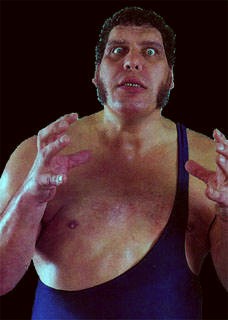 For many people, Andre the Giant is the epitome of professional wrestling. One of the biggest stars of the 1970s, he had three tremendous advantages as a wrestler:
For many people, Andre the Giant is the epitome of professional wrestling. One of the biggest stars of the 1970s, he had three tremendous advantages as a wrestler:
Andre started off a skinny but muscular giant when he first emerged as a wrestler in France, then jumped the Atlantic to begin working the robust Canadian circuit. His fame soon spread to the U.S. market. His size was his obvious selling point, and his increasing bulk created an increasingly formidable appearance. Billed as the "eighth wonder of the world" (after a line in King Kong), he was often advertised as weighing more than 500 pounds, which was actually true at his peak weight, but not through most of his career.
Andre was a rare mainstream star in the days before Vince McMahon Jr. created the first nationwide wrestling promotion. McMahon booked Andre as a special attraction, moving him from city to city, and loaning him out to other territories, resulting in much wider exposure than most of his peers enjoyed. McMahon also booked Andre on one of the longest legitimate undefeated streaks in modern pro wrestling history, which lasted almost 10 years and cemented the Giant as an unstoppable force, or more aptly, an immovable object, too large to be pushed around by the usual wrestler's tactics.
Although he was already the best-known name in professional wrestling, McMahon propelled Andre to even greater heights of fame when he took the WWF to national television in the early 1980s. His iconic status was cemented with his well-received role of Fezzik in The Princess Bride (1987).
He could also drink prodigiously, in amounts that would kill a lesser man. The legends may or may not be exaggerated. At one point, it was said he drank two cases of beer a day (although his tolerance was so high because of his size that he could hardly be called an alcoholic). He would occasionally indulge himself by ordering the entire menu at a restaurant.
But his ever-more-massive frame put tremendous stress on his knees and other joints, which not only carried all 400-plus pounds of him on a daily basis but also suffered abuse inside the ring. Even ordinary-sized wrestlers frequently experience knee problems, but acromegaly is particularly hard on the joints, including knees, shoulders, and hips. The last years of Andre's life were spent in significant and often severe pain, and he found it increasingly difficult to move about in the ring.
Andre was the epitome of wrestling throughout the '70s, and Hogan was the rising star to emerge from the 1980s. With Andre's health now sharply declining, it was time to pass the torch. He did so in memorable style. The two faced off before a sellout crowd in the main event of Wrestlemania III, a match that culminated with Hogan lifting Andre into the air and bodyslamming him to the mat for the win. The visual impact of Hogan powering through the legendary 500-pounder was devastating, and the win was historic, since Andre had done so few jobs during his run as a main eventer. Wrestlemania III was the beginning of Hulk Hogan's historic rampage through the annals of professional wrestling as one of the industry's greatest stars.
After a few months of quiet retirement, Andre died of heart failure related to his acromegaly, bedridden in his native land. His legacy continued after his death when the seven-foot Paul Wight debuted as "The Giant" with Ted Turner's World Championship Wrestling using a gimmick that claimed he was Andre's long-lost son. (He wasn't.)
Outside the wrestling world, Andre was memorialized by Shepard Fairey in his a sticker-campaign called "Andre the Giant Has A Posse" (later renamed "Obey Giant") which was an artistic effort to simulate a spontaneous cultural outpouring over Andre's iconic status. In the end, "iconic" was the word that summed him up. For fans of all eras, Andre remains perhaps the ultimate embodiment of wrestling's nobler aspects, which would otherwise tend to get lost in the sea of bad taste and steroid abuse into which modern wrestling has submerged. Like the mythological giant he resembled, Andre seemingly belonged to a different age.
|
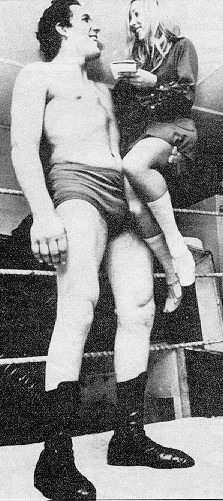 Andre had a gentle demeanor (in both his private and public lives), which combined with his awe-inspiring size to make him an extremely effective babyface (good guy) wrestler. He worked under a variety of unnecessarily clever stage names until joining the WWF in 1972, when Vince McMahon Sr. gave him the simple sobriquet that would define his career.
Andre had a gentle demeanor (in both his private and public lives), which combined with his awe-inspiring size to make him an extremely effective babyface (good guy) wrestler. He worked under a variety of unnecessarily clever stage names until joining the WWF in 1972, when Vince McMahon Sr. gave him the simple sobriquet that would define his career. 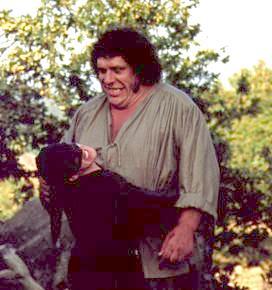 Andre carved out a substantial name for himself and crossed over to mainstream entertainment, notably appearing as the
Andre carved out a substantial name for himself and crossed over to mainstream entertainment, notably appearing as the 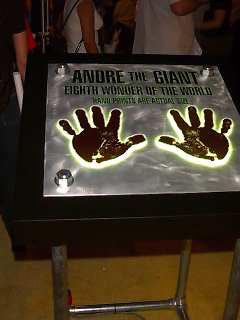 But even as his star continued to rise, his health began to decline. Andre had continued to gain weight, due to his acromegaly, which fueled appetites proportionate to his size. On a light day, Andre ate twice as much as anyone else in the room (even when "anyone else" included other professional wrestlers).
But even as his star continued to rise, his health began to decline. Andre had continued to gain weight, due to his acromegaly, which fueled appetites proportionate to his size. On a light day, Andre ate twice as much as anyone else in the room (even when "anyone else" included other professional wrestlers). 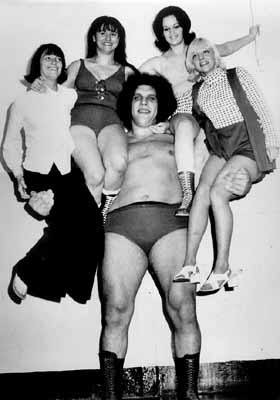 Andre was beloved both by the fans and his fellow wrestlers. His gimmick of the "gentle giant" carried through every aspect of his life, even in the ring, where he extremely careful not to accidentally injure his fellow performers with his incredible size and strength. (Uncharacteristically, he was once arrested for allegedly manhandling a cameraman, but he never spent time in jail over the incident.)
Andre was beloved both by the fans and his fellow wrestlers. His gimmick of the "gentle giant" carried through every aspect of his life, even in the ring, where he extremely careful not to accidentally injure his fellow performers with his incredible size and strength. (Uncharacteristically, he was once arrested for allegedly manhandling a cameraman, but he never spent time in jail over the incident.)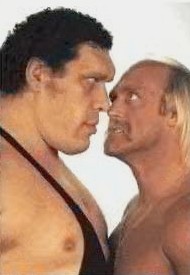 The peak of his wrestling career came in the late 1980s, when he was called on to "do the job" and lose a high-profile match. The WWF had launched its highly successful pay-per-view event Wrestlemania in 1985, and it immediately became the Superbowl of pro wrestling. Shortly before Wrestlemania III, Andre turned heel ("bad guy" in wrestling jargon) in a shocking betrayal and turned on his "best friend," Hulk Hogan.
The peak of his wrestling career came in the late 1980s, when he was called on to "do the job" and lose a high-profile match. The WWF had launched its highly successful pay-per-view event Wrestlemania in 1985, and it immediately became the Superbowl of pro wrestling. Shortly before Wrestlemania III, Andre turned heel ("bad guy" in wrestling jargon) in a shocking betrayal and turned on his "best friend," Hulk Hogan. 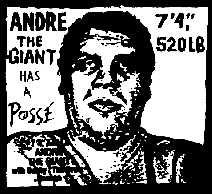 For Andre, it was the beginning of the end. Hogan and Andre continued to feud over the title for more than a year, but the Giant's disease had progressed and he was in virtually constant pain. His ability to perform declined, and after slipping down the card, he eventually stopped performing altogether.
For Andre, it was the beginning of the end. Hogan and Andre continued to feud over the title for more than a year, but the Giant's disease had progressed and he was in virtually constant pain. His ability to perform declined, and after slipping down the card, he eventually stopped performing altogether. 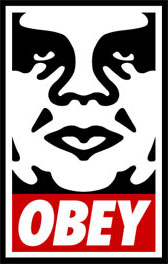 Andre still pops up occasionally in wrestling video games and video releases, some done on the cheap with obscure footage from the pre-WWF days and others featuring his career highlights. On a more dignified note, Andre became the first inductee into the WWF (now WWE) Hall of Fame in 1993.
Andre still pops up occasionally in wrestling video games and video releases, some done on the cheap with obscure footage from the pre-WWF days and others featuring his career highlights. On a more dignified note, Andre became the first inductee into the WWF (now WWE) Hall of Fame in 1993.